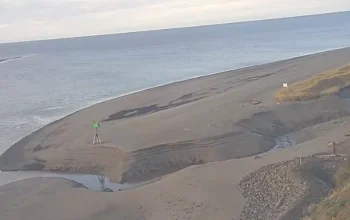
Webcams Near Boone, NC
Virtually Explore With Boone North Carolina Live Cam
The Boone North Carolina Live Cam, located at High Mountain Expeditions, lets you experience the beauty of the South Fork New River Tubing area. It offers clear views of lush landscapes, flowing water, and local wildlife. This live stream brings the peaceful charm of Boone right to you.
The Boone NC live cam captures the Blue Ridge Mountains and their vibrant greenery. It also provides opportunities to spot wildlife, including birds, deer, and other animals. This view showcases Boone’s peaceful connection to nature.
Things to Do in Boone, North Carolina
Boone, North Carolina, nestled in the Blue Ridge Mountains, offers a variety of attractions for nature lovers, history buffs, and families. Here are some must-visit spots in and around Boone.
Grandfather Mountain
- Address: 2050 Blowing Rock Highway, Linville, NC 28646
Grandfather Mountain is famous for its Mile High Swinging Bridge, offering breathtaking views of the Blue Ridge Mountains. The area has hiking trails for all skill levels, from easy walks to challenging climbs. Wildlife habitats featuring black bears, cougars, and otters make this a perfect stop for families.
Blue Ridge Parkway
- Access Point Near Boone: Milepost 291.8
Known as “America’s Favorite Drive,” the Blue Ridge Parkway offers stunning scenic views, picnic areas, and hiking trails. Near Boone, Julian Price Memorial Park features a serene lake, ideal for canoeing and fishing. The Price Lake Loop Trail provides an easy hike with beautiful mountain views.
Linville Caverns
- Address: 19929 US-221, Marion, NC 28752
Explore the underground world beneath Humpback Mountain at Linville Caverns. Guided tours take visitors through winding passages filled with unique rock formations. The caverns stay at a cool 52 degrees year-round, making them a refreshing escape from the summer heat.
Mystery Hill
- Address: 129 Mystery Hill Lane, Blowing Rock, NC 28605
Mystery Hill is a mind-bending attraction where gravity seems to work in reverse. Water flows uphill, and balls roll upwards, defying logic. The Hall of Mystery features interactive science exhibits, while Tomahawk Hill offers axe-throwing fun for all ages.
Tweetsie Railroad
- Address: 300 Tweetsie Railroad Lane, Blowing Rock, NC 28605
Tweetsie Railroad is a Wild West-themed amusement park centered around an authentic steam locomotive. Families can take a scenic train ride while watching cowboy and Indian reenactments. The park also has classic amusement rides, live entertainment, and a petting zoo, making it perfect for kids.
Boone, NC, offers a mix of adventure, history, and natural beauty. Whether you’re hiking, exploring caverns, or riding a historic train, there’s something for everyone in this mountain town.
The History of Boone, North Carolina
Boone, North Carolina, is a town rich in history, culture, and Appalachian tradition. Located in the Blue Ridge Mountains, Boone has grown from a small frontier settlement into a thriving college town. It is named after Daniel Boone, the legendary explorer and pioneer, who spent time in the area during his travels. Over the years, Boone has played an important role in education, transportation, and the arts.
Daniel Boone and Early Settlers
Boone takes its name from Daniel Boone, the famous frontiersman and explorer. He camped in the area several times during his hunting and exploration trips. His influence on the region was so strong that early settlers honored him by naming the town after him.
Some of Boone’s earliest settlers were Jesse and Jonathan Boone, nephews of Daniel. They were among the first members of Three Forks Baptist Church, which was founded in the late 1700s and still exists today. These early pioneers helped establish Boone as a hub for settlers moving into the western frontier.
Geography and Climate of Boone, North Carolina
Boone, North Carolina, sits in the Blue Ridge Mountains in the northwestern part of the state. The town’s high elevation gives it a unique climate compared to other areas in North Carolina. Boone experiences cool summers, cold winters, and frequent snowfall. The stunning mountain landscape, rolling hills, and winding rivers make it a beautiful place to visit or live.
Geography of Boone
Location and Elevation
Boone is located in Watauga County, close to the Tennessee border. It stands at an elevation of 3,333 feet, making it one of the highest towns on the East Coast. Because of this, Boone stays cooler than most of North Carolina throughout the year.
Surrounding Mountains and Valleys
The Blue Ridge Mountains surround Boone, giving it breathtaking scenery. These mountains are part of the larger Appalachian Mountain range, one of the oldest in the world. The valleys between the mountains feature lush forests, clear rivers, and diverse wildlife.
Rivers and Waterways
Several rivers run through or near Boone. The New River, one of the oldest rivers in the world, flows through the region. The Watauga River, another important waterway, provides a source of recreation and natural beauty. These rivers support local wildlife and help supply water to the town.
Forests and Natural Areas
Boone is home to large forests filled with a variety of trees, including oak, hickory, maple, and pine. These forests change color dramatically in the fall, drawing visitors from across the country. The area also contains protected lands like the Blue Ridge Parkway and Grandfather Mountain State Park, both offering hiking, camping, and outdoor adventures.
Climate of Boone
Cool Summers
Boone has mild summers due to its high elevation. Average high temperatures in July, the warmest month, reach about 78°F (26°C). Even on hot days, cool breezes make the weather comfortable. At night, temperatures often drop into the 50s (10–15°C), providing relief from the summer heat.
Cold Winters and Snowfall
Winters in Boone can be cold and snowy. January, the coldest month, has average low temperatures around 20°F (-7°C). Snow is common, with the town receiving around 35 inches of snow each year. This makes Boone a popular spot for skiing and winter sports.
Rainfall and Fog
Boone gets plenty of rain throughout the year, averaging around 50 inches annually. Spring and summer often bring afternoon thunderstorms, while fall tends to be drier. Because of its high elevation, Boone also experiences foggy mornings, especially in the spring and fall.
Beautiful Fall Foliage
Autumn in Boone is stunning. The changing leaves turn bright shades of red, orange, and yellow. The crisp air and scenic mountain views attract thousands of visitors every year. The Blue Ridge Parkway offers some of the best views of the fall colors.
How the Geography Affects Life in Boone
Outdoor Activities
The geography and climate make Boone a great place for outdoor activities. People enjoy hiking, camping, fishing, and skiing throughout the year. The mountains and rivers provide endless opportunities for adventure.
Agriculture and Wildlife
The cool climate and fertile valleys allow farmers to grow apples, Christmas trees, and fresh vegetables. The forests and rivers also support diverse wildlife, including black bears, deer, and wild turkeys. Birdwatchers visit Boone to see species like the pileated woodpecker and red-tailed hawk.
Tourism and Economy
Boone’s geography and climate attract visitors all year. In the summer, people come for hiking, rafting, and camping. In the fall, leaf peeping draws large crowds. Winter brings skiers and snowboarders to the nearby slopes. Tourism plays a big role in Boone’s economy.
Boone, North Carolina, offers stunning geography and a unique climate. Surrounded by mountains, rivers, and forests, the town provides natural beauty and outdoor adventure. Its cool summers, snowy winters, and colorful autumns make it a special place to live and visit.
The Railroad and the 1940 Flood
In the late 19th century, Boone was connected to the outside world by the East Tennessee and Western North Carolina Railroad. Locals called it the “Tweetsie Railroad” because of the high-pitched whistle of the steam engines. This narrow-gauge railway helped bring goods and people to the region, making Boone an important trade center.
However, in 1940, a massive flood destroyed much of the railroad tracks. The damage was so severe that officials decided not to rebuild the railway. This ended the era of rail travel in Boone, although today, Tweetsie Railroad remains a popular heritage attraction near town.
Boone Becomes a College Town
Education has played a major role in Boone’s growth. The town is home to Appalachian State University (ASU), a major institution in the University of North Carolina system. ASU is now the sixth-largest university in the state, attracting students from across the country.
In addition to ASU, Caldwell Community College & Technical Institute operates a campus in Boone. These institutions have transformed Boone into a center for education and research while also boosting the local economy.
Horn in the West: Boone’s Outdoor Drama
Since 1952, Boone has hosted “Horn in the West,” an outdoor drama that tells the story of the early settlers of the region. The play features Daniel Boone as a central character, bringing history to life for visitors and locals alike.
The performance takes place in a scenic amphitheater and has become a summer tradition. Many actors have played the role of Daniel Boone over the years, but Glenn Causey, who performed for 41 seasons, is the most well-known. His image is still used in many depictions of Boone in the area.
The Junaluska Community
Boone is also known for Junaluska, a historic community just north of downtown. This area was settled by free African Americans before the Civil War. It remains one of the few historically Black communities in the Appalachian region.
During the mid-20th century, racial integration led to many local Black-owned businesses closing as commerce shifted to downtown Boone. However, descendants of the original families still live in the neighborhood today. Junaluska is also home to a majority-African American Mennonite Brethren congregation, making it unique in the region.
Boone and Appalachian Music
Music and storytelling are central to Boone’s culture. The town has long been a hub for bluegrass musicians and Appalachian storytellers. Many famous artists have connections to Boone, including:
- Doc Watson – A Grammy-winning bluegrass guitarist and singer.
- Michael Houser – Founding member and lead guitarist of the band Widespread Panic.
- Old Crow Medicine Show – A popular folk and bluegrass band.
- The Blue Rags – A ragtime and blues-influenced group.
- Eric Church – A country music star and Boone native.
Boone continues to celebrate its musical heritage with festivals, live performances, and cultural events throughout the year.
Boone, North Carolina, has a deep and rich history that reflects the spirit of exploration, resilience, and creativity. From Daniel Boone’s legendary adventures to the establishment of Appalachian State University, the town has evolved while preserving its Appalachian roots. Today, Boone remains a lively and welcoming place where history, education, and music come together in the heart of the Blue Ridge Mountains.
Grandfather Mountain State Park: A Natural Wonder
Grandfather Mountain State Park is one of North Carolina’s most breathtaking destinations. Standing at 5,946 feet, it is the highest peak in the Blue Ridge Mountains. The mountain is over 300 million years old, with some rock formations dating back 1.2 billion years. Its rugged beauty, diverse wildlife, and challenging hiking trails make it a favorite spot for outdoor lovers.
A Protected Natural Treasure
Grandfather Mountain is part of the Southern Appalachian Biosphere Reserve, recognized by the United Nations. The park protects a wide range of plant and animal species, including black bears, deer, and rare salamanders. The high-altitude forests are home to red spruce and Fraser fir trees, which are more common in Canada than in the southern United States.
A nonprofit organization, the Grandfather Mountain Stewardship Foundation, manages part of the mountain as a scenic attraction. Proceeds from admission fees and souvenirs help protect the mountain and educate visitors about its natural wonders.
The Famous Mile High Swinging Bridge
One of the most thrilling experiences at Grandfather Mountain is walking across the Mile High Swinging Bridge. This 228-foot suspension bridge sits one mile above sea level and connects two peaks. Visitors enjoy 360-degree views of rolling mountains stretching to the horizon.
To reach the bridge, guests drive along a scenic, winding road to the summit parking area. From there, they can either climb 50 stairs or take an elevator inside the Top Shop for easy access.
The Top Shop also features a gift shop, restrooms, and a small nature exhibit. This area is wheelchair accessible, making it possible for everyone to enjoy the stunning views.
Wildlife and Nature Discovery
Grandfather Mountain is home to several wildlife habitats where visitors can observe animals in a natural setting. These habitats include:
- Black Bears – Watch these powerful yet playful animals up close.
- Cougars – Learn about these elusive mountain cats.
- River Otters – See these energetic creatures swim and play.
- Elk – Discover one of North America’s largest land mammals.
The Wilson Center for Nature Discovery, located near the animal habitats, offers interactive exhibits about the mountain’s history, geology, and ecosystems. Visitors of all ages can explore hands-on displays and learn about conservation efforts.
Challenging Hiking Trails
For those seeking adventure, Grandfather Mountain State Park offers some of the toughest trails in the Southeast. Unlike the scenic drive to the bridge, the state park’s trails are only accessible by foot.
Popular Trails:
- Profile Trail (3.6 miles one way) – Begins off NC Highway 105 and climbs steeply to Grandfather Mountain’s ridgeline.
- Daniel Boone Scout Trail (3 miles one way) – Starts from the Blue Ridge Parkway and leads to Calloway Peak (5,946 feet), the highest point in the park.
- Grandfather Trail (2.4 miles) – A rugged, high-altitude trail that includes ladders, cables, and rock scrambles.
Hikers must register at the trailheads before beginning their trek. These trails offer breathtaking views but require good physical condition and proper gear.
Events and Educational Programs
From April to October, Grandfather Mountain hosts daily programs and special events. Educational programs include:
- Guided nature walks
- Wildlife demonstrations
- Stargazing nights
- Photography workshops
Annual events like the Grandfather Mountain Highland Games celebrate Scottish heritage with music, dancing, and athletic competitions.
Dining and Picnic Areas
Visitors can enjoy a meal at Mildred’s Grill, located inside the Wilson Center. The restaurant serves hot food, snacks, and drinks. Favorites include:
The Mile High Burger
• Fresh salads and wraps
• Homemade fudge
For those who prefer picnicking, Grandfather Mountain has over 100 picnic tables in scenic spots. The Half Moon Overlook, with its stunning views of Linville Peak, is a popular choice.
Seasonal Beauty and Changing Views
Grandfather Mountain is beautiful year-round. Each season brings different landscapes and experiences:
- Spring – Wildflowers bloom, covering the slopes in bright colors.
- Summer – Cool mountain breezes offer relief from the heat.
- Fall – The leaves turn brilliant shades of red, orange, and gold.
- Winter – Snow and ice create a stunning, peaceful scene.
No matter the season, the mountain’s beauty never fades.
Plan Your Visit
Grandfather Mountain is open year-round, except on Thanksgiving and Christmas Day. Visitors can purchase tickets online and reserve a time slot to enter the park. The state park trails are free to access but require registration at the trailheads.
For those seeking breathtaking views, exciting hikes, and unforgettable experiences, Grandfather Mountain State Park is a must-visit destination.


